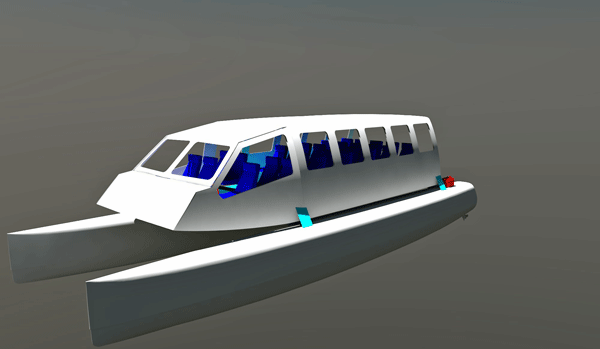This just showed up. The design has been updated since this was done. And I am doing a version with a more protected cockpit next.
http://themarineinstallersrant.blogspot.com/2015/11/local-boats-i-like-eco-trekker.html?m=1
This just showed up. The design has been updated since this was done. And I am doing a version with a more protected cockpit next.
http://themarineinstallersrant.blogspot.com/2015/11/local-boats-i-like-eco-trekker.html?m=1
Notice how the tension members on the A frames are treated. These two wire systems each have have roughly double the forestay load on each of them. Stainless does not like to be cold-worked. A thick continuous wire making a sharp turn is a classic failure mode. It is less costly. I am a bitch about details like this. Mine cost more to do, but are more reliable. This is a mission critical part of the catamaran.
Now the cheaper way. And look how planning for the furler down low helps. Get it done right.
I’m catching up enough to take the time to post things I saw early this summer. Here is an interesting comparison again on the 65 charter cats. Side by side my 65 daycharter Alii Nui and a Trilogy 65 by Marples. Both were built by Schooner Creek only a few years apart. The Constant Camber 65 was interesting because it had almost everything that CM had 30 years ago (and still does) and almost nothing that CC had back then; except having to build a surfaced mold.
Here are two ways to do the bow tube ends. First, Alii Nui. Notice how the tramp extrusions on the hull are at the same plane as the slide groove in the mast section. The tramp can be flat and secure. Notice also that the hull brackets are on the inboard side, not the top. That allows a shorter bow tube, which is stronger. And no chance to trip over the bracket on deck.
Now the other cat. And notice how the vertical tabs can bend back under load. I imagine they will have to keep after the caulk joints at the hull. Notice above how the bracket is bolted to the hull. No delta at all.
Back on Kauai again in May. I didn’t get a chance to do an intervention. Keep in mind Buckminster Fuller’s concept of getting the most performances out of a certain amount of materials. An imaginary blob of foam, glass and epoxy could go many ways.
I don’t know who designed this unit, but the owners could have had a far better daycharter cat, like the Alii Nui. I was told it has the same or more weight than my 65, and carries the same number of passengers. The deep draft, overhanging bow and heavy rocker tells me that it will pitch like a dog, and require huge engines to move at any speed. And being so narrow and tall, it will roll like crazy in beam on waves. If I could have only made an intervention.
I got to visit Jim Betts boatyard last Friday, and also find out the foil story. Richard was right in an earlier note. After they strip plank the plug, instead of spreading resin on the strip and sanding it, they foil it. The foil is squeegied down like laminate would be, then mold release is added.
At first I thought this part was one of the Perry monohulls. Joel had to explain to me that it was the topsides and deck of the stretched 37 that I designed for him. With the reverse bows. Notice the foiled lower part of the hull in the lowest picture, to the right.
I just read of his passing in Pro Boat. Am I the only person who didn’t know?
I met him at one of the multihull design conferences held in Southampton back in the early 90s. He was a monohull designer who did his first trimaran, a Formula 40 tri, that was faster than any of its competition. I remember him as light hearted and unassuming. Godspeed.
Guys, make sure you believe and follow your mission statement before you build the hulls. Once again, the hulls were built before the mission statement was final. This 39′ power cat ferry is now required to have 36 seats and a perfectly flat floor. 3 years ago it was designed on almost no budget for far fewer passengers and no comment on the floor. It needs 5′ more length to carry the weight. Two studies on locating the cabin.
Piece of a 787 hull at Future of Flight. Visited with the kids Saturday. All carbon fiber. Compared to the thousands of rivets on the metal hull, I wondered what took them so long.
Probably if I had taken the Boeing tour I would know, but the stringers looked small compared to the hull thickness.
The hull is too large to co-cure, so the stringers probably help joining the sections. And help with global loads. I doubt if they help much with the pressure vessel.
This is interesting as my builders are facing rapidly increasing core costs, and decreasing shear strength. Stringers and frames are looking more attractive. Is interesting to see what unlimited funds for structure analysis came up with. My builder Terry Neilson uses glass over a pvc pipe half round.